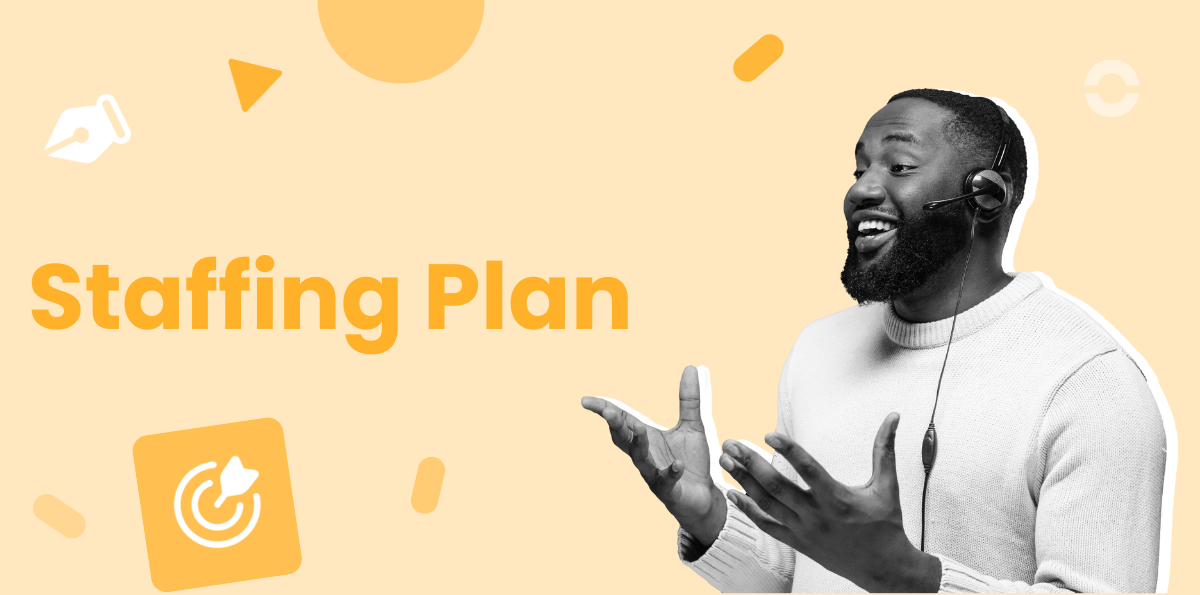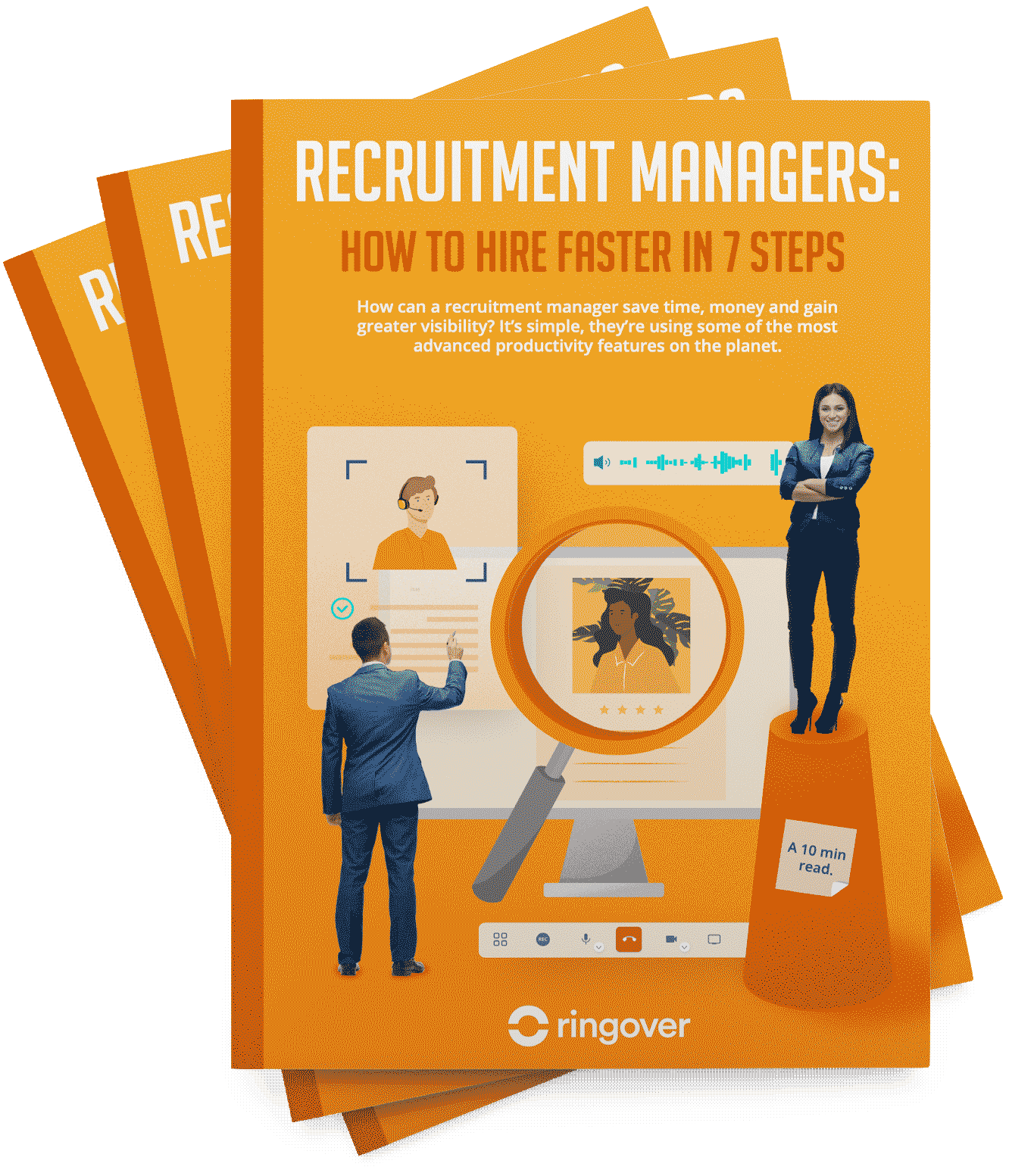Summary
Whether you're looking to expand your sales team, integrate new staffing technologies, or simply maintain a roster of highly skilled employees, a thoughtfully developed staffing plan is your compass through the intricacies of workforce management and overcoming staffing industry challenges.
Discover Ringover for Staffing
This article will walk you through the steps of crafting a staffing plan that works, from grasping the necessary recruiting techniques to effectively deploying it within your enterprise.
What Is a Staffing Plan?
A staffing plan is a roadmap designed to guarantee that an organization has employees with appropriate skills, in the correct roles, at the perfect time. It's an integral part of workforce planning, a comprehensive process that synchronizes the organization's workforce with its business aims and strategic objectives.
A vital element of a staffing plan is its emphasis on both present and future staffing requirements. It includes end-to-end recruitment, evaluating the current workforce to pinpoint skill and personnel gaps, and then projecting future needs based on business expansion, strategic objectives, and market dynamics. This forward-thinking approach facilitates targeted recruitment, candidate relationship management, training, and development strategies, ensuring the team is primed to tackle forthcoming challenges.
Ultimately, a staffing plan serves as a comprehensive guide for the HR department in executing recruiting outreach, training, and retention strategies. It aids in forecasting future demand, managing labor costs efficiently, and sustaining a workforce that is balanced—avoiding situations of being understaffed or overstaffed. Consequently, it enables the organization to achieve its volume or project targets efficiently and effectively.
How Do You Create a Staffing Plan? 6 Steps
Creating a staffing plan is a methodical process that involves several key steps to ensure your organization is well-prepared to meet its current and future workforce needs.
Here are the six essential steps to guide you through this process:
Step 1: Evaluate Goals
The first step in developing a staffing plan is to evaluate the goals and objectives of your organization. This involves understanding what the business needs to achieve in the short and long term.
Align your departmental goals with the overall organizational goals to ensure that your staffing efforts support the broader strategic objectives. Reach out to other leaders to understand their expectations, including support for major projects, new strategic initiatives, or other changes that will require adjusting staff.
Step 2: Identify Influencers and Understand Labor Trends
Identify the internal and external factors that might influence your staffing plan.
This includes labor trends, economic conditions, industry changes, and any other variables that could impact your workforce needs. Understanding these influencers helps you anticipate and prepare for potential challenges and opportunities.
For example, if your industry is experiencing a skills shortage, you may need to plan for additional training or recruitment strategies.
Step 3: Analyze the Current State of the Function
Analyze the current state of your workforce by compiling information on all current resources, including staff, contractors, and other support personnel. This step involves assessing the competencies, skill sets, and expertise of your current employees to understand what tools and capabilities are presently available.
Use workforce and staffing analytics to gain data-driven insights into your current staffing landscape, including employee performance, turnover rates, and career paths.
Step 4: Envision Needs
In this step, envision what will be needed to accomplish the goals set out in Step 1. Approach this step as if you are building the department from scratch, without being influenced by the current state.
Identify both end-state staffing and interim needs, considering both head count and skill set requirements. This helps articulate the necessary roles, skills, and competencies without being hampered by existing biases.
Step 5: Conduct a Gap Analysis
Conduct a gap analysis to identify the differences between the current state of your workforce and the envisioned future state. This analysis helps you determine what additional skills, knowledge, or personnel are needed to meet your business objectives.
It also highlights areas where internal development or external recruitment may be necessary to fill the gaps identified.
Step 6: Develop a Solution Plan
Having conducted the analysis above, develop a comprehensive plan to achieve the stated goals. This plan should include both end-state staffing and any interim staffing needs. It should outline the staff needed, the timing for hiring or promoting specific staff, and the allocation of costs if the staffing plan is being done in conjunction with a budget cycle.
The plan should differentiate between full-time and contingent staff and identify every role needed, from entry-level to executive positions. It may also detail the timing for when specific external expertise is needed.
Build a strong tech stack by integrating your VoIP phone with your ATS and CRM so you can benefit from automatic data synchronization and productivity features like click-to-call.
What Is the Purpose of a Staffing Plan?
The purpose of a staffing plan is multifaceted and essential for the overall success and sustainability of an organization. Here are some of the key objectives and benefits that a well-crafted staffing plan achieves:
Aligning with Business Objectives
A primary purpose of a staffing plan is to ensure the organization's human resources are in sync with its business goals. By comprehensively understanding the company's strategic objectives, a staffing plan ensures the deployment of individuals with the necessary skills to support these goals. This alignment is instrumental in achieving both short-term and long-term targets, such as increasing sales revenue, enhancing product development cycles, or improving customer service.
When you're looking to better meet your business objectives, don't forget to take your business software into account. Many staffing agencies take advantage of integrations to build a comprehensive set of solutions. CRMs like HubSpot and Salesforce help staffing agencies organize their clients and candidates, while ATS like Bullhorn and Vincere assist with organizing the recruiting process.
Finally, consider solutions related to communications. Omnichannel contact center software like Ringover allows you to reach clients and candidates on the right channel at the right time. Not to mention, Ringover's VoIP software provides a range of power IP telephony features like call monitoring, call recording, and ranks among one of the most useful Bullhorn integrations–though Ringover offers a variety of integrations with many software.
If you're looking to improve performance immediately and in the long run, consider deploying Empower by Ringover. This conversation intelligence software uses sentiment analysis to analyze conversations between recruiters, candidates, and clients to extract key insights. This data helps staffing managers understand communication trends, improve recruiter performance, and make informed decisions on candidate sourcing.
Anticipating and Filling Skills Gaps
Identifying discrepancies between the existing skills of the workforce and those required for future success is an essential aspect of a staffing plan.
Through detailed skills gap analysis, organizations can formulate targeted training programs and recruitment strategies to bridge these gaps. This forward-thinking approach not only prepares the team to tackle forthcoming challenges but also fosters business continuity and growth.
Managing Labor Costs
Optimizing labor costs is fundamental in effective staffing planning.
By precisely determining staffing requirements, organizations can steer clear of both understaffing and overstaffing. The former may lead to overtime expenses and diminished productivity, whereas the latter can unnecessarily inflate payroll costs. A staffing plan maintains a balanced workforce, minimizing financial waste and ensuring efficient use of resources.
Mitigating Business Risks
A staffing plan considers various internal and external factors that could influence staffing needs, including industry trends, economic conditions, and labor market dynamics.
This foresight aids in mitigating risks associated with abrupt market or industry shifts, ensuring the business remains resilient and adaptable. It also plays a critical role in managing risks tied to failed projects, customer dissatisfaction, and missed opportunities.
Enhancing Productivity and Efficiency
A well-crafted staffing plan guarantees that the right individuals occupy the right roles at the right time, significantly boosting productivity and efficiency. With a skilled and well-aligned workforce, organizations can experience quicker project completion times, elevated customer satisfaction, and an overall improvement in performance.
Supporting Succession Planning
Incorporating succession planning, a staffing plan is vital for preparing the organization for future leadership and key role transitions.
This process involves identifying potential successors, equipping them with necessary training and development, and ensuring a seamless transition when key positions become available.
How Do You Write a Project Staffing Plan?
Writing a project staffing plan differs from a staffing plan because it outlines the staff needed for a specific project, not for a company at large. A project staffing plan is a detailed and structured process that ensures you have the right people with the right skills at the right time to execute your project successfully.
1. Define Project Objectives and Scope
Begin by clearly defining the project's objectives, scope, and timelines. This step is vital as it sets the foundation for determining the human resources needed. Align the project goals with the overall business strategy to ensure that the staffing plan supports the broader organizational objectives.
2. Assess Current and Future Staffing Needs
Determine the current staffing situation and forecast future staffing needs based on the project's requirements. This involves analyzing the number of people needed, their skills, and the locations where they will be required. Use historical data, industry benchmarks, and statistical analyses to estimate the staffing requirements accurately.
3. Conduct a Gap Analysis
Perform a gap analysis to identify the discrepancies between the current workforce and the future staffing needs. This analysis helps in pinpointing skills gaps, understaffing, or overstaffing issues. It also aids in deciding whether to recruit new talent, promote internally, or focus on training and development programs to fill the gaps.
4. Outline Staff Roles and Responsibilities
Clearly outline the roles and responsibilities required for the project. This includes specifying the skills, experience, and certifications needed for each role. For proposals, it may be necessary to include the names and resumes of key personnel, especially if specified by the Request for Proposal (RFP).
5. Develop a Resource Management Strategy
Create a resource management strategy that details how you will manage the project team. This includes planning for recruitment, onboarding, training, and retention. Outline how you will handle subcontractors, teaming agreements, and the allocation of work among team members. Also, include strategies for managing project team attrition and ensuring smooth transitions when team members leave the project.
6. Establish a Timeline and Budget
Develop a detailed timeline and budget for the staffing plan. This involves determining when to hire or promote specific staff, assigning costs, and ensuring that the plan aligns with the project's budget cycle. The timeline should include milestones for hiring, training, and deploying staff to their assignments.
7. Include Onboarding and Training Plans
Outline the onboarding procedures and training plans for new project team members. This ensures that new staff are integrated smoothly into the project team and have the necessary skills and knowledge to perform their roles effectively. Include information on what new members will be provided with during onboarding and the expectations for their onboarding experience.
8. Review and Update the Plan
Finally, ensure that the staffing plan is regularly reviewed and updated to reflect any changes in the project scope, timelines, or staffing needs. This involves revisiting the plan periodically to ensure it continues to meet the project's requirements and making adjustments as necessary.

What Is Included in a Staffing Management Plan?
A comprehensive staffing management plan is a detailed and structured document that encompasses several key elements to ensure the optimal management of an organization's human resources.
Workforce Assessment
A thorough workforce assessment is the foundation of a staffing management plan. This involves a meticulous analysis of the current workforce, including an evaluation of skills, experience, qualifications, and aspirations of current employees. This assessment helps in identifying the strengths and weaknesses of the team, determining where to invest in training and development, and addressing any immediate gaps in skills or personnel.
Forecasting Staffing Needs
Forecasting future staffing needs is a critical component of the plan. This involves predicting the quantity and type of talent required based on the organization's strategic objectives, anticipated changes in workload or demand, and external factors such as market trends and economic conditions. This forward-looking approach enables the organization to proactively plan for future staffing needs and avoid last-minute hiring decisions.
Job Analysis and Role Definition
A clear understanding of the roles within the organization is essential. This involves breaking down each position to define its responsibilities, qualifications, and potential career progression paths. Such a detailed job analysis helps in recruitment, guides employees in understanding their roles and responsibilities, and ensures that the right people are in the right positions.
Recruitment Strategy
The recruitment strategy outlines how the organization will attract and select new talent. This may include a blend of internal promotions, external hires, or outsourcing for specialized skills. An effective recruitment strategy ensures that the organization consistently attracts and retains high-quality talent. It should also detail the sourcing, screening, interviewing, and onboarding processes.
Training and Development
The staffing management plan should identify areas where training and development programs can enhance the skills and knowledge of the workforce. These programs are essential for keeping employees up-to-date with industry trends and ensuring the organization remains competitive and adaptable. Training plans should be aligned with the organization's strategic goals and include both short-term and long-term development opportunities.
Staffing Timeline
A staffing timeline is essential for outlining specific milestones or project phases that necessitate adjustments in staffing levels or skillsets. This includes identifying key deliverables and deadlines throughout the project lifecycle to anticipate when additional personnel may be required or when certain roles may become redundant. The timeline should also detail the duration and sequencing of recruitment activities.
Budgetary Considerations
The plan must include budgetary considerations to ensure that staffing costs are managed effectively. This involves estimating the costs associated with hiring, training, and retaining staff, as well as considering the financial implications of different staffing strategies. Budgeting should be aligned with the overall financial health and strategic goals of the organization.
Performance Management
Performance management is a vital component of the staffing management plan. It involves setting clear performance expectations and objectives for employees, outlining specific goals they are expected to achieve within a given timeframe, and strategies for recognizing and rewarding high performance. This helps in motivating employees and reinforcing desired behaviors.
Succession Planning
Succession planning is essential for ensuring that the organization is prepared for future leadership and key role transitions. This involves identifying potential candidates, providing them with the necessary training and development, and ensuring a smooth transition when key positions become available. Succession planning helps in maintaining continuity and stability within the organization and ultimately achieving effective recruitment.
Conclusion
In conclusion, developing an effective staffing plan is an essential step in ensuring the success and sustainability of your organization. Remember to align your staffing plan with your business objectives, conduct a thorough analysis of your current and future staffing needs, and avoid introducing new ideas or apologizing in your conclusion.
A well-crafted staffing plan helps in managing labor costs, mitigating business risks, and enhancing productivity. It also supports succession planning and ensures that your workforce is equipped with the necessary skills to meet future challenges.
When combined with a well-considered tech stack, you got the recipe for successful execution of a staffing plan. To get started, consider a free trial of Ringover or Empower by Ringover, so you can see the difference they make yourself!




